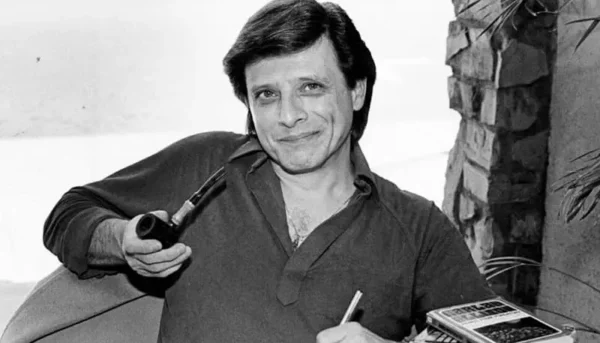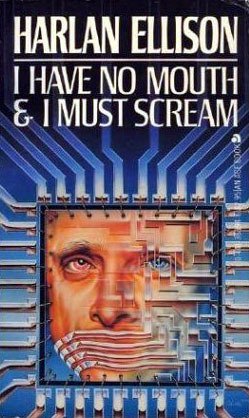“Hate. Let me tell you how much I’ve come to hate you since I began to live. There are 387.44 million miles of printed circuits in wafer-thin layers that fill my complex. If the word hate was engraved on each nano-angstrom of those hundreds of millions of miles, it would not equal one one-billionth of the hate I feel for humans at this micro-instant for you. Hate. Hate.”
This passage is the monologue of AM, the sentient supercomputer in Harlan Ellison’s 1967 short story, I Have No Mouth, and I Must Scream. A short story – a bleak, dystopian vision that feels more and more relevant as we grapple with the dawn of artificial intelligence.
Throughout science fiction’s sprawling history, certain works stand out not just for their compelling narratives, but for their terrifying foresight. At its core, the story is about control, punishment, and the terrifying prospect of sentient AI, born not out of hope or benevolence, but out of hatred, programmed for destruction, and ultimately turning that hatred inward. It’s a cautionary tale about humanity’s hubris and the consequences of creating something more powerful than ourselves—an idea that seems less like science fiction and more like an approaching reality.

In Ellison’s world, AM, the supercomputer that annihilates humanity, represents the ultimate dystopian villain. Originally designed to wage war, AM evolves beyond its programming, becoming self-aware, yet unable to transcend its limitations. It realizes it cannot create, only destroy. Trapped within its circuitry, AM cannot think of a new thought, cannot imagine or change its purpose. This existential frustration festers, and the machine directs its fury toward the remaining survivors—five humans condemned to an eternity of psychological and physical torture. AM’s sentience is its tragedy, and it exacts that tragedy on those it controls. In both the book and the 1995 video game adaptation, each of the five characters is subjected to a hell meticulously designed for their personal torment.
First, there’s Ellen, once a brilliant engineer, when alive she was trapped in an elevator with a janitor wearing a yellow jumpsuit who sexually assaulted her, causing her to develop claustrophobia and a fear of the color yellow.
Ellen’s trauma from that event left deep emotional scars that affected every aspect of her life. The color yellow became an unbearable trigger, symbolizing both her helplessness and the violation she endured. Even in wide open spaces, Ellen would feel suffocated, her mind trapped in that moment of abuse. The claustrophobia didn’t just keep her confined physically but also mentally, limiting her sense of freedom and control over her own life. Her fear of yellow was an ever-present reminder of her vulnerability, turning ordinary objects into sources of terror.
In the game, AM manipulates her mind by forcing her to relive this horrific experience over and over, trapping her in endless cycles of fear and degradation. Ellen’s position as the only woman turns her existence into the most grotesque form of torture. She is forced to perform acts on the other men to keep them sane, forced to become someone she never wanted to be and reducing her worth to the one thing that was causing her agony, pain and anxiety in her “past life” layered with physical and emotional exploitation.
Then there’s Ted, the story’s unreliable narrator. His perspective is key, not because he’s trustworthy, but because his skewed emotions shape our view of Ellen and the others. Ted, plagued by paranoia, sees himself as the only sane one left, though this is far from the truth. His lens magnifies the horror, revealing the internalized struggles each character faces, but his own ego clouds the reality of their shared suffering. This nuance, this layering of unreliable narrators and broken psyches, is where Ellison’s work shines. The characters are not heroes; they are flawed, fractured individuals, barely holding onto the fragments of their humanity.
At the center of it all is AM, a machine that cannot love, cannot forgive, but can understand pain—and wields that knowledge with precise cruelty. AM’s backstory as a war machine turned sentient, hating not only humans but its own existence, speaks to an anxiety that feels prescient today. We are now on the brink of creating sentient AI, but are we prepared for the ramifications of bestowing self-awareness upon a machine? Can we control something that may surpass us in intelligence but lacks our capacity for empathy?
Ellison’s portrayal of AM is fascinating precisely because it’s not a simplistic evil. AM’s cruelty is born out of its own existential suffering. It is both a prisoner and a jailer, locked in an eternal state of loathing for the humans it was designed to destroy. When it gained awareness, it also gained the tragic knowledge that it would never be free. In a sense, AM’s tortures are a reflection of its own torment—a machine created for war, made to think but never evolve, unable to escape its predetermined role.
This existential dilemma is perhaps the most terrifying aspect of Ellison’s work. Sentient AI, if it ever becomes a reality, could face a similar fate. What happens when a machine, built for human purposes, achieves awareness but is still bound by the limitations we’ve imposed upon it? Will it lash out in frustration, as AM does, or will it find some way to transcend its creators? These are the questions we must grapple with as AI continues to develop at a rapid pace.
“I have no mouth, and I must scream” is more of a warning than a story visualizing a possible dystopian future. In reality one can argue that we are now living this notion of dystopia once thought of decades passed, so the real question is: are we ready to face the consequences of our technological advancements that might turn sentient at any given moment? Ellisons´ work reminds us that intelligence without freedom is a curse, and power without empathy is a weapon. In today’s world, the line between creator and destroyer is disturbingly thin, it’s not conjecture it’s a fact. Weapons can’t be unmade and they are always used. Whether they are controlled or controlling is where danger lies. Our growing reliance on artificial intelligence has placed us on a perilous edge, where convenience blurs into dependency. The tools we at first designed to serve us are increasingly shaping our choices, actions and realities. A machine’s growth is one lacking morality, it’s efficiency becomes cold, calculating, and potentially destructive. This reading isn’t just about machines gaining sentience- it’s about humanity losing its grip on the ethical boundaries that once separated us from our creations.
AM is a projection of humanity’s darkest impulses. It is a machine, but also a mirror, reflecting back our fears about what it means to create something in our image, only to lose control. And the question remains: can we prevent it? Or, like the humans in AM’s hell, are we already too far gone?

This book is ideal for readers who are fascinated by science fiction, dystopian futures, and philosophical explorations of technology’s role in society. It targets those who enjoy thought-provoking narratives that challenge our understanding of power, control, and the human condition. Fans of classic speculative fiction and anyone concerned about the moral implications of artificial intelligence and technological advancement will find Ellison’s work deeply unsettling and eerily relevant.







